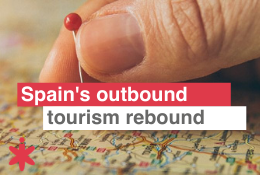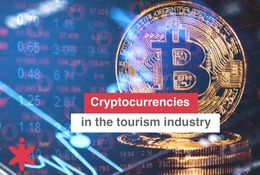Spain’s outbound tourism rebound: The road to recovery from COVID-19 .

Top 10 tourism initiatives of the week.
17/04/2020
Curro’s Journey, a trip around the world in times of confinemen.
29/04/2020Spain’s outbound tourism rebound: The road to recovery from COVID-19 .

Destinations and travel brands that were benefiting from the steady growth of Spanish outbound travel before the world ground to a halt in March need to rethink their strategies before they restart their marketing engines.
“New normal” has dethroned “over tourism” as the destination marketing catch phase of 2020 and we all need to start considering why, when, where and how the Spanish people will travel internationally when restrictions are lifted. In this, the first part of in-depth analysis needed to draw up a roadmap for recovery of outbound travel, we focus on the “Why?” and on understanding the emotional and practical aspects of the Spanish traveler’s unique path to purchase that give us cause for cautious optimism.

Part 1.
Spain ranks third in the World in international tourism arrivals. Quite an achievement for a relatively small country and a credit to the a deeply ingrained culture and way of life based on warm hospitality, joie de vivre and whatever the opposite of social distancing is.
Coincidence or not, Spain, for all its touchy-feely, fun-loving, carefree hospitality also ranks third in the list of countries that have suffered the most fatalities from the COVID19 virus. As soon as the pandemic is under control, the effect on the economy of not receiving international visitors will be the Spanish government’s immediate concern as the virus, or the lockdown it has caused, has effectively killed off 16% of Spain’s GDP for 2020. The recovery of tourism and repairing of any damage to Spain’s brand equity as a tourism powerhouse is, understandably, a priority and something that is receiving a lot of political, media and public interest.
But what about outbound travel? How will this crisis affect attitudes to the attitudes and behavior of Spanish tourists?
Whilst small in comparison to inbound tourism, there is a whole industry dedicated to facilitating international travel for Spanish residents on which hangs the livelihood of thousands of families, both here in Spain and in the international destinations that over recent years have come to depend on the growing number of Spanish visitors.
I am a huge believer in the importance of data and advocate for any strategy that is built on the sound foundations of analysis and interpretation of empirical data. Indeed, this data-driven methodology has been the secret ingredient to some of our most successful destination marketing campaigns over recent years. But, when the world suddenly stops moving, the always comforting certainly of mathematical algorithms becomes less relevant and past strategic models can either bend or crack. So, when asked by clients and colleagues to depict the famous “new normal” for Spanish outbound travel, the image I offer cannot aspire to be a photograph but, at best, an artist’s impression created with equal doses of experience, interpretation and imagination. This, for what it is worth, is how see it today:
Travel decisions involve both hemispheres of the brain.
The right hemisphere needs to be inspired by intangibles such as beauty, affection, emotion and only then does it go to the pragmatic left hemisphere for approval of the analytical tangibles of price, convenience or safety. So, when analyzing the effect of COVID19 on the Spanish travel market we need to address both sides of the Spanish tourist’s brain to consider both the psychological and the practical effects.
First let’s delve into the right hemisphere. I actually believe that the same joie-de-vivre, fun-loving attitude to life that has proven so effective in drawing international visitors to Spain will be the key to the swift recovery of the outbound tourism industry. We have seen from recent crises in different tourism destinations, from terrorism in Paris or London to hurricanes in the Caribbean, that Spanish outbound tourism, although often residual, is resilient and among the first to bounce back to pre-crisis levels. Whilst the current crisis is of a scale never seen before and affects just about every tourism destination and every tourism source market in the world, the morale of the Spanish population at large and the wanderlust of that relatively small percentage of the population that travel, remain strong.
Northern European tourists travel in hordes to “escape” their daily routines, and particularly their weather, to get their annual fix of sun and sangria. Southern Europeans are essential content where they are and need other motivations to persuade them to leave their own sun and wine-soaked coasts and cities to venture abroad. Spanish, French and Italian tourists are motivated by adventure, cultural interaction and exploration. Over recent years international tourism destinations have been forced to focus on sustainability and many have noticed the Spanish outbound market for the first time as representing more value for less volume than other European markets. As DMOs start to design their COVID19 recovery strategies they will need to consider a third V to their segmentation modelling and compare markets for their Volume, Value and also for their Valor. Call them brave, reckless, simply uninformed but the fact is that Spanish tourists are less sensitive to health and safety than many other Europeans. In balance Spain could be a surprising yet smart choice for 2021-2022 for destination marketers until some of the more risk-adverse markets regain confidence.
Whilst studying emotional intelligence and its effects on travel, we can see a direct and inverse relationship between experience and fear. People fear what they don’t know, and resilience is a result of experience. As a nation that has suffered the full blow of a deadly pandemic (and managed to stay remarkably positive throughout the onslaught), it stands to reason that Spanish travelers will be relatively unconcerned about the risks of infection whilst on vacation almost anywhere else in the world. Indeed, in the case of Spain and Italy the irrational fear of infection is more likely to affect the destinations than the tourists as close interaction with locals is a key motivator for Spanish tourists and they will be very sensitive to any hint of stigmas or rejection. The hitherto implicit guarantee of a warm welcome specific to Spanish tourists will need to be explicitly and clearly communicated in any post-COVID19 destination marketing campaigns.
Spain’s social nature also affects he composition of travel parties. Most people travel in small groups of family or friends. These small FIT groups allow for private transfers that avoid the need for either mass public transportation or large tour buses that are potential sources of infection and turn-offs for travelers.
 So if it were left purely to the right hemisphere of the brain to make the decision to travel abroad in late 2020 or early 2021, I would say that the Spanish market would be a fairly safe choice for marketers of any destination that meets the minimum requirements expected of a post-Covid19 vacation: Open spaces, acceptable hygiene, trusted accommodation. The desire to travel is strong if there is the opportunity. Cue the left hemisphere.
So if it were left purely to the right hemisphere of the brain to make the decision to travel abroad in late 2020 or early 2021, I would say that the Spanish market would be a fairly safe choice for marketers of any destination that meets the minimum requirements expected of a post-Covid19 vacation: Open spaces, acceptable hygiene, trusted accommodation. The desire to travel is strong if there is the opportunity. Cue the left hemisphere.
What are the practical implications of COVID19 on Spanish outbound travel?
First, we have the most obvious practical impediment of not legally being allowed out of our homes, let alone out of the country. I am not even going to guess when full freedom of movement will be restored in Spain but it will be roughly at the same time as the rest of European source markets and most likely not before the very end of Q3 or mid Q4 2020. The relaxing of confinement will be in phases (starting next week) but the first international travel will be for business, study and some VFR and the earliest leisure travel will probably not start until Christmas. This brings us to another practical impediment…availability to travel. Anyone fortunate enough to have a job to go back to will most likely not have enough paid time off left for 2020 for much more than a short break. This is because many companies have obliged their staff to take their annual leave whilst the companies have been closed.
Talking of closed companies, we can all expect a severe global recession to last for several years and Spain, precisely due to its dependence on the tourism industry, will definitely feel the macro-economic pinch as much as anyone. But here again, Spain is an interesting exception to the rule of tourism marketing logic precisely because of its relatively small number of international travelers. Not everybody in Spain travels abroad but those that do earn more and spend more than the average tourist from Northern Europe or even North America. Whilst the economic recession will of course affect travel demand, this has more to do with consumer confidence than disposable income. In the 2008 recession, Spain’s economy collapsed almost as suddenly as it’s property bubble burst and yet every year from 2008 – 2019 international travel from Spain has continued to grow seemingly unaffected by the adverse economic climate. This is down to three main reasons: first because Spain was a latecomer to the outbound tourism party and the market curve has still not reached the stage of maturity let alone decline. There is enough momentum in the market growth to make it hard to halt altogether. The second reason is that the majority of travelers are from the higher socioeconomic echelons and whilst the lower and particularly the middle classes (that make up the bulk of travel from Northern European markets), suffered the consequences of the recession, the country’s rich became richer. Thirdly a significantly, and some would say disproportionately, large part of the Spanish labor force works for the public sector and whilst civil servants’ disposable income may not increase, they have enough job security to be confident they can afford a vacation.
This economic crisis however is very different to that of 2008 because it is not cause by speculation and greed but by a terrible blow to the country’s main employer, Tourism. This brings us back to the beginning of this article and the conclusion that speed of recovery of outbound tourism from Spain will depend on the speed of recovery of inbound tourism.

Here, somewhat against the odds, I also find cause for optimism as the other important practical factor affecting travel is accessibility and Spain’s attraction as a world class destination affords it some great connectivity by air, road, rail and sea. Airlines are already talking about reopening their flights to Madrid and Barcelona in June and what comes in must go out. The connectivity is assured and is very expensive for carriers and where there is financial risk there is promotional effort and I expect the same airlines that have recently been indifferent about leisure travel and focused on the more lucrative business class will be keen to work closer than ever with international destinations to rebuild consumer demand and confidence.
And talking of partnerships, I also expect this crisis to accelerate the process of consolidation of all areas of the industry from distribution channels, hotel brands or airlines that was already started in the 2008 recession and will be something we look into in more detail in Part 2.
CHRIS POMEROY
CEO INTERFACE TOURISM SPAIN


 All the news
All the news  Back to newsroom
Back to newsroom


